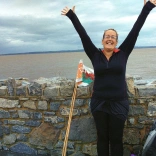Hiking from one town or village to another, changing accommodation every night, isn’t everyone’s cup of tea, but it’s not the only way to experience the Wales Coast Path. While researching two of the official guidebooks to the trail, I completed significant chunks of it using trains and buses – and was pleasantly surprised at just how easy and how much fun it was.
Eryri (Snowdonia) by train
The Cambrian Coast Railway follows the smooth curve of Cardigan Bay from Pwllheli in the north to Aberystwyth in the south (via Machynlleth). There are a surprisingly large number of stations along this relatively short stretch of line – 30 in total – with trains running every couple of hours. This allows Wales Coast Path walkers considerable flexibility when deciding how far they want to walk each day.
When my partner Heleyne and I walked the 49-mile (79km) section from Porthmadog to Aberdyfi along the coast of the Eryri (Snowdonia) National Park, we based ourselves at Harlech and Barmouth (Abermaw). We used the train to walk linear stretches of the path, alternating days of 12 to 14 miles (19-23km) with shorter walks of between 6 and 9 miles (10-15km). Hopping on and off trains, watching the paths we’d just walked through the carriage windows and chatting with other hikers doing a similar thing, became part of the adventure.
Our fairly relaxed approach, especially on the gentler days, gave us more time for visiting attractions such as the fanciful Italianate village of Portmeirion and the crag-top ruins of Castell Harlech (Harlech Castle). It also meant we could dawdle, enjoying the views – with Yr Wyddfa (Snowdon) visible on clear days – or simply watching birds searching for food out on the sandbanks. The Eryri (Snowdonia) coast takes in wooded estuaries, salt-marshes rich in wildlife, immense dune systems and long, sandy beaches that seem to stretch on endlessly. You’ll want time to take in the beauty and serenity that is present here all year round.


We were in our campervan, so were staying on campsites, but there are also dozens of hotels, guesthouses and self-catering cottages all along this coast. As well as Harlech and Barmouth, other good places for exploring the area include Porthmadog and Tal-y-bont in the north, and Tywyn and Aberdyfi in the south.
Ceredigion made easy
Beyond Aberdyfi, the Wales Coast Path swings inland to cross the Afon Dyfi near Machynlleth before snaking its way back to the coast at Borth. The landscape begins to change here, as walkers now stride out along the cliffs of Ceredigion. Over the coming days, the scenery grows in grandeur, culminating in high, windswept precipices that tower over secluded beaches and jagged offshore sea stacks. One of the many highlights is the dramatic, exposed cliff path south of Cwmtydu, near New Quay.


Having caught a direct train from Wolverhampton, I used the vibrant university town of Aberystwyth as my base to walk the 60-mile (96km) Ceredigion Coast Path. I split it into five sections – Ynyslas (just north of Borth) to Aberystwyth; Aberystwyth to Llanon; Llanon to New Quay (Ceinewydd); New Quay to Aberporth; and Aberporth to Cardigan (Aberteifi).

Other than on the first two days, this meant catching buses at the beginning and end of each day, but with the T5 bus to Cardigan starting early and finishing late in the afternoon Monday to Saturday, this was easily done. To check times ahead of your daily walk – including the 512 bus to Ynyslas and trains to Borth – use the route planner on the Traveline Cymru website.
There’s also the option of dividing the route into more than five days by breaking the stages at Llanrhystud, Aberarth and Aberaeron, all of which are served by the T5. Alternatively, if you’d rather not spend so long on buses, you could choose two or even three different bases. While Aberystwyth has something to suit most budgets, there’s also a good range of accommodation in the charming harbour town of Aberaeron, the seaside resorts of New Quay and Aberporth, and in Cardigan, which is also the jumping-off point for the next stretch of the Wales Coast Path – through Pembrokeshire…


Pembrokeshire by bus
Possibly the wildest, most spectacular section of the entire trail, the Pembrokeshire Coast Path winds its undulating way along the rugged fringe of the south-west corner of Wales – from St Dogmael’s (Llandudoch), near Cardigan, to Amroth Castle on the border between Pembrokeshire and Carmarthenshire. Jaw-dropping coastal formations, secluded coves, prehistoric burial sites, wheeling seabirds, friendly towns and villages, excellent pubs and restaurants… It’s all here. Plus there are the buses…
The Puffin Shuttle. The Celtic Coaster. The Coastal Cruiser. These are the evocative names of some of the services that allow walkers to hike the full 186 miles (300km) of the National Trail from just a handful of bases, rather than staying in different accommodation every night. I’d recommend travelling out by bus at the start of each day on the trail and then walking back to your accommodation – especially if, like me, you don’t like to feel under pressure to rush your walk.
There are recognised bus stops in towns and villages, but once you’re in the countryside, you can flag down a bus anywhere on its route. I’ve always found the friendly drivers to be knowledgeable about the local area and they’ll help you find suitable drop-off and pick-up points. The Cardi Bach bus service (552) runs between Cardigan and New Quay, calling at Llangranog, Aberporth, Cwmtydu and Mwnt on Fridays and Saturday, and between Cardigan and Llangrannog on Thursdays.
Pembrokeshire is also part of the fflecsi scheme which allows bus passengers to book their journey via an app or by phone, and then be picked up and dropped off at a convenient point. Wales on Rails provides lots of information on attractions and trails on the bus and train routes
As on the other sections of the trail, check timetables on the Traveline Cymru website when planning your trip, particularly if you’re thinking of visiting out of season. The Pembrokeshire County Council website also has helpful information about the services and how to use them.





